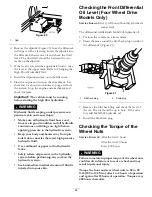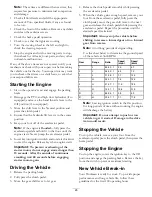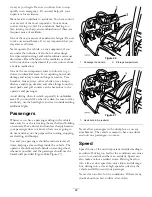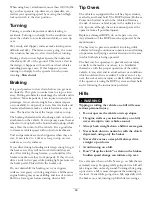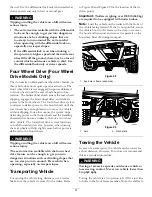
Figure 35
1.
Left rear corner of bed
4.
Clevis pin
2.
Vehicle frame channel
5.
Lynch pin
3.
Pivot plate
CAUTION
The full bed weighs approximately 325 lb (147.5 kg),
so do not try to install or remove it by yourself. Use
an overhead hoist or get the help of two or three
other people.
Note:
Ensure that the spacer brackets and wear blocks
(Figure 36) are installed with the carriage bolt heads
positioned inside the machine.
Figure 36
1.
Spacer bracket
3.
Carriage bolt
2.
Wear block
1. Ensure that the lift cylinders are fully retracted.
2. Carefully set the bed onto the vehicle frame aligning
the rear bed pivot plate holes with the holes in the
rear frame channel and install 2 clevis pins and lynch
pins (Figure 36).
3. With the bed lowered, secure each cylinder rod end,
to the appropriate slots in the bed mounting plates
with a clevis pin and lynch pin. Insert the clevis pin
from outside of the bed with the lynch pin toward
the outside (Figure 36). The rear slots are for a full
bed installation and front slots are for a 2/3 bed
installation.
Note:
The engine may need to be started to extend
or retract the cylinders for alignment with the holes.
Keep fingers out!
Note:
The unused slot can be plugged with a bolt
and nut to prevent assembly errors.
4. Start the engine and engage the hydraulic lift lever
to raise the bed. Release the lift lever and turn off
the engine. Install the bed safety support to prevent
accidental lowering of the bed. Refer to Using the
Bed Safety Support.
5. Install the lynch pins to the inside ends of the clevis
pins.
Note:
If the automatic tail gate release has been
installed on the bed, ensure that the front dump link
rod has been placed on the inside of the left side
clevis pin before the lynch pin is installed.
Jacking the Vehicle
DANGER
A vehicle on a jack may be unstable and slip off of
the jack, injuring anyone beneath it.
•
Do not start the vehicle while the vehicle is on a
jack.
•
Always remove the key from the switch before
getting off of the vehicle.
•
Block the tires when the vehicle is on a jack.
•
Do not start the engine while the vehicle is on a jack,
because the engine vibration or wheel movement
could cause the vehicle to slip off of the jack.
•
Do not work under the vehicle without jack stands
supporting it. The vehicle could slip off a jack,
injuring any one beneath it.
•
When jacking up the front of the vehicle, always
place a 2 x 4 block (or similar material) between the
jack and the vehicle frame.
•
The jacking point at the front of the vehicle is under
the front center frame support (Figure 37) and at the
rear it is under the axle (Figure 38).
38
Summary of Contents for 07367TC
Page 41: ...Figure 44 41...
Page 60: ...Schematics Hydraulic Schematic Rev B High Flow Hydraulics Schematic TC models only Rev A 60...
Page 61: ...Electrical Schematic Rev B 61...
Page 62: ...Notes 62...
Page 63: ...Notes 63...

